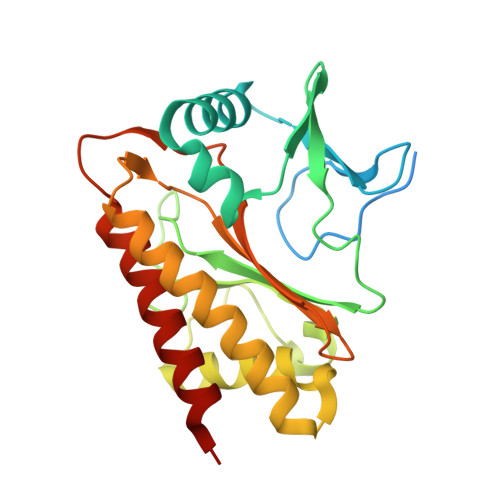Biochemical and structural characterization of an inositol pyrophosphate kinase from a giant virus.
Zong, G., Desfougeres, Y., Portela-Torres, P., Kwon, Y.U., Saiardi, A., Shears, S.B., Wang, H.(2024) EMBO J 43: 462-480
- PubMed: 38216735
- DOI: https://doi.org/10.1038/s44318-023-00005-0
- Primary Citation of Related Structures:
8T8U, 8T8V, 8T8W, 8T8X, 8T8Y, 8T8Z, 8T90, 8T91, 8T92, 8T93, 8T95, 8T96, 8T97, 8T98, 8T99, 8TF9, 8TFA - PubMed Abstract:
Kinases that synthesize inositol phosphates (IPs) and pyrophosphates (PP-IPs) control numerous biological processes in eukaryotic cells. Herein, we extend this cellular signaling repertoire to viruses. We have biochemically and structurally characterized a minimalist inositol phosphate kinase (i.e., TvIPK) encoded by Terrestrivirus, a nucleocytoplasmic large ("giant") DNA virus (NCLDV). We show that TvIPK can synthesize inositol pyrophosphates from a range of scyllo- and myo-IPs, both in vitro and when expressed in yeast cells. We present multiple crystal structures of enzyme/substrate/nucleotide complexes with individual resolutions from 1.95 to 2.6??. We find a heart-shaped ligand binding pocket comprising an array of positively charged and flexible side chains, underlying the observed substrate diversity. A crucial arginine residue in a conserved "G-loop" orients the ¦Ă-phosphate of ATP to allow substrate pyrophosphorylation. We highlight additional conserved catalytic and architectural features in TvIPK, and support their importance through site-directed mutagenesis. We propose that NCLDV inositol phosphate kinases may have assisted evolution of inositol pyrophosphate signaling, and we discuss the potential biogeochemical significance of TvIPK in soil niches.
Organizational Affiliation:
Inositol Signaling Group, Signal Transduction Laboratory, National Institute of Environmental Health Sciences, National Institutes of Health, Research Triangle Park, NC, 27709, USA.


















